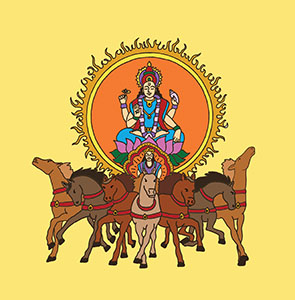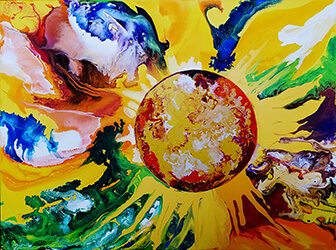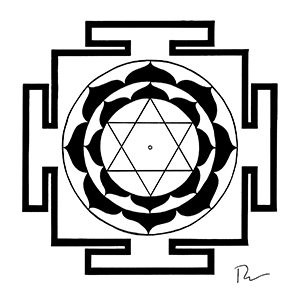Watch nearly 400 videos on the Vocal Medicine Channel!
Surya Mantra: Sun God of Hinduism
Surya is a Hindu sun god revered as the source of light and life. Surya rides in a golden chariot driven by Aruna, a personification of the dawn. The chariot is pulled by seven horses representing the seven chakras or energy centers. In terms of symbolism, the sun is usually associated with the masculine; the moon with the feminine.
Share this page with a friend!
Surya Mantra in Sanskrit and in English
Mantras are a form of yoga: practices for spiritual development through physical exercises or disciplines. Like yoga poses, each mantra emphasizes a specific flow of energy. The mantra below in Sanskrit and in English is like a vocal equivalent of the Sun Salutation poses in hatha yoga.
Lyrics: Om Sam Suryaya Namaha
English Meaning: I offer salutations to the sun.
Sun God of Egypt
In ancient Egypt, the sun was associated with three deities: Horus, Ra and Osiris. Horus represents the rising sun. Osiris is the setting sun. Ra represents the sun’s zenith. In astrology, the sun is an expression of the outward self, the self that “shines” towards others.
Sun Mantras for the Eyes
Mantras to the sun are believed to be the most powerful healing mantras. The energy of the sun is believed to heal all types of conditions. The sun is particularly advantageous for healing the eyes and vision. Learn more about all types of mantras to support wellness in the article Healing Mantras.

Understanding the Surya Mantra
In Vedic astrological mantras, the Sanskrit seed syllable “sam” (suum) connects to the fundamental vibration of the sun, giver of life and energy in this physical dimension. The use of an astrological mantra is a significant part of this branch of Vedic sciences. An astrological mantra mitigates challenging aspects and amplifies positive configurations.
Using Astrological Mantras
Astrological mantras improve karmic outcomes at all levels to heal the body and mind. They can also help to improve situations in a larger sense such as the fate of nations or of Earth itself. Each mantra is said to work in the subtle or unseen realms that influence our lives in every area.
The Power of Cycles
There are specific times when astrological mantras are purported to be the most effective: solstices, equinoxes, eclipses, new and full moons and sunrise, noon and sunset. However, astrological mantras can also be used at any time. Read full article on Astrology Mantras.
Story of the Hindu Sun God Surya
In the early Vedic period, the sun god Surya reigned supreme. In later Hindu periods, only certain sects worship Surya as a central deity. In many branches of Hinduism, Vishnu has largely taken over the role of Surya. In spite of this shift, there are many mantras are dedicated to Surya.
The Sun and the Element of Gold
The sun has long been associated with gold. In one story, the Surya gives a gift to a devout follower. The gift from the sun god is a magical gem that can produce a huge quantity of gold on a daily basis. However, this only occurs if the owner is good. If the owner behaves in an evil manner, the stone has deadly powers as well.
Ancient Quest of Alchemy
The transformation of base metals or sunlight into gold is an ancient quest. Empires have been built and continents explored in the search for gold. Gold is believed to reflect the sun or to be solidified sunlight. The sun represents the self in its most exalted form: the self that shines.
Symbolism of the Sun
The impact of the sun is universal: the sun is the most prominent symbol in our world. Images of the sun have graced interior environments since the time of the cave dwellers. The sun has been personified extensively, creating a pantheon of sun gods around the world. Each have their own mythology and unique creation stories.
Power of the Sun
The sun literally powers our world. Thus, the sun brings hope, cheerfulness, and optimism. The sun is one of the first things children draw spontaneously. We instinctively desire to remind ourselves of the power and life-giving comfort of the sun!
Meaning of the Sun
The sun symbolizes positivity, clarity, confidence and power. The sun is generally related to masculine energy, growth and higher consciousness. Dreams of the sun are usually good omens: everything works out when the sun is shining. Bringing this energy into our world through sun mantras is an uplift both psychologically and emotionally.
Politics and the Sun
Throughout history, many rulers have associated themselves with the sun to emphasize their own inherent power. This includes the ancient Egyptians as well as more recent hierarchs such as Louis XIV, known as the Sun King.
Religious Symbolism of the Sun
In the religious sphere, traditional Christian symbolism depicts Christ as the “sun” as well as the “son” of God. This is particularly true of the Celts. The rounded Celtic cross depicts the physical sun and Christ simultaneously. Archangel Michael is also symbolized by the sun.
Mythology of the Sun
The sense of awe inspired by the heavens is a universal phenomenon. People in nearly every culture have found great joy in studying the skies. Many cultures have myths and stories based on various configurations of the sun, the moon and the stars.
Names of the Sun in Mantras
There are also twelve names of the sun god, each corresponding to a different pose in the practice of Sun Salutations in hatha yoga. Each name can be used in Surya mantras. The Surya names in Sanskrit and English are as follows:
Om Mitraya Namah (Friend of all)
Om Ravaye Namah (Praised by all)
Om Suryaya Namah (Guide of all)
Om Bhanave Namah (Bestower of beauty)
Om Khagaya Namah (Stimulator of the senses)
Om Pushne Namah (Nourisher of all)
Om Hiranyagarbhaya Namah (Creator of all)
Om Marichaye Namah (Destroyer of disease)
Om Adityaya Namah (Inspirer)
Om Savitre Namah (Purifier)
Om Arkaya Namah (Radiant One)
Om Bhaskaraya Namah (Illuminator)
Surya Mantra Example
An example of a mantra to Surya as Bhaskaraya or the giver of wisdom and illumination is given below:
Om Bhaskaraya Vidmahe
Om Maha Tejaya Dimahe
Om Surya Namaha Om Surya
Om Tanno Surya Prochodayat
The meaning of the Chant to the Sun in English is the following: “Let me meditate on the Sun. Let me think about the highest power. I bow before the Sun. Homage to the Sun! Let the Giver of life illumine my mind.”

Sun Deities Around the World
The alphabetical list below is just a few of the sun deities found in cultures around the world. Solar mythologies explain the sun’s movement across the sky, often traveling in a chariot or boat. In China, the sun is simply viewed as the male or “yang” principle, personified as a great cosmic eye. This is in contrast with the feminine or “yin” principle. Although most cultures view the sun as masculine, in Celtic lore the sun represents feminine power.
Meaning of the Sun in Astrology
In astrology, the sun represents the self, shining outwardly towards the world. There are many solar symbols including animals, gemstones, flowers, and the geometric form of the circle or wheel. Solar animals include the hawk, lion, salamander, rooster, horse, ram, phoenix, eagle, lion, dragon, and bull. Solar metals and gems include bronze, gold, diamond, ruby and topaz. Learn more about healing gems and crystals in the article Chakra Stones and Meaning.
Devouring the Sun
Many cultures also have stories of monsters or creatures that devour the sun. These myths may be associated with the phenomena of solar eclipses. Other myths show the foolishness of attempting to reach or interact with the sun. In Hinduism, some say the monkey-faced god Hanuman tried to eat the sun as a child, thinking the sun was an orange. Learn more about this beloved and fascinating hindu god in the article Hanuman Mantra.
Alphabetical List of Sun Gods & Goddesses
Amaterasu: Shinto Sun God
Japanese sun goddess and a central figure to the Shinto religion. The emperors in Japan claim to be descendants of Amaterasu. This is what gives them the divine right to rule. Amaterasu has a brother who is the moon. When he misbehaves, she retreats to a cave. This causes a crisis as the earth is without light or warmth. Eventually the other gods trick her into returning to the world from her cave.
Arinna/Arinniti: Hittite Sun Goddess
Sun goddess in Hittite mythology. The Hittites were a people located between Greece, Assyria, and the Red Sea. Arinna was called the “Queen of All Lands.”
Apollo: Greek God of Illumination
Olympian god of many different things, including the sun. God of music, light, poetry, healing, plague, prophesy, knowledge, order, beauty, archery, and agriculture. Apollo supplanted Helios in Greek mythology.
Belenus: Celtic Sun God
Celtic sun god whose journey was viewed as a yearly rather than a daily cycle. The Celtic celebration in the spring is called Beltane in his honor.
Freyr/Freya: Norse Sun Goddess
Norse sun goddess. Freya is the goddess of sunshine, rain, fertility, and peace.
Helios: Greek Sun God
An Olympian god believed to drag the sun behind a golden chariot in the sky during the day, returning during the night. Helios is the god of oaths and vision. Helios dwells in a golden palace near the river Oceanus. Each day he leaves this palace driven by four winged steeds. He is crowned with the areole of the sun and dressed in purple robes. When Helios reaches the far west, he descends into a golden cup that bears him back to his rising place in Oceanus. Helios is closely identified with other fire gods including Hephaestus and Apollo.
Hebat/Hepa: Asia Minor Sun Goddess
Asia Minor goddess made the national goddess by the Hittites. Renamed Arinna.
Huitzilopochti: Aztec Sun God
Aztec deity of war, sun, human sacrifice, and was also the patron of the city of Tenochtitlan.
Huar Khshaita: Zoroastrian Sun God
Zoroastrian deity of the “radiant sun.”
Intil/Apu Punchau: Incan Sun God
Inca sun god believed to be the ancestor of the Inca people.
Jóhonaa’éí: Navajo Sun God
Navajo sun bearer who carries the sun across the sky on his back. At night he hangs the sun on a peg on the wall as he rests for the labors of the following day.
Liza: African Sun Goddess
Fon people of West Africa associated this goddess with the sun.
Lugh/Lug: Celtic Sun God
Ancient Irish god. He was so prominent that in Victorian times he was considered to be a sun god. Lugh is a skilled warrior who carries a magic spear. He is also the god of storms and lightning. Perhaps most importantly, Lugh is the god of the harvest and grain. Lugh is accordingly the patron of artisans and farmers.
Mithra: Iranian Sun God
God of sun, justice, contract, and war in pre-Zoroastrian Iran.
Ra: Egyptian Sun God
Egyptian god seen as the sun at midday. Later he was combined with Amun to make a “solar creation god” and became known as Amun Ra. The ancient Egyptians had three different sun gods to indicate the position of the sun in the sky. Horus is the rising sun, Osiris is the setting sun and Ra represents the sun at the highest point or zenith in the sky. Other experts view each of these gods as stages in life for a single god. Ra is a creator god traveling through the sky and through the underworld at night. Ra vanquishes the evil serpent Apopis.
Sol/Sunna: Norse Sun Goddess
Norse sun goddess who rode a horse-drawn chariot.

Sun Art and the Surya Yantra
The Surya Yantra is sometimes called the Radiance Yantra. The twelve outer petals are known as the celestial beams of the sun. They are symbolic of the twelve months of the year and the twelve astrological signs. The sun is the regal master of the entire solar system and the visible universe.
Benefits of the Sun Yantra
Focusing on the Surya Yantra can be particularly appropriate for extending yourself into new social situations, travel or undertaking adventures in life. Surya is a celebration of light and illumination in yourself and others. When colored, the Surya Yantra is decorated with flaming red, orange, silver and gold.
Mantra for the God of the Sun
The mantra associated with the Surya Yantra is “Om Hram Hrim Hraum Sah Suryay Namaha.” As the god of the sun, Surya brings illumination, healing and spiritual magnetism. The yantra and the mantra are both tools for guiding the thoughts and feelings in healthy patterns, but the viewer’s intention is paramount.
Sun Art and Flower Symbolism
There are many flowers that are directly associated with sun symbolism. This is particularly true of flowers that are yellow or orange in color. Other flowers associated with the sun bloom early in the year as the first signs of the return of the sun after the winter. The shape of many flowers also mimics the sun: a central disc with radiating petals.
Yellow Flowers and Sun Art
Yellow flowers are the heralds of spring. Sunshine yellow flowers symbolize the clearing away of the winter and stimulate clear thinking. The color meanings of yellow are enthusiasm, confidence, cheerfulness, sense of humor, fun, optimism and intellectuality.
Yellow flowers mean friendship in the Victorian language of flowers. Well-known yellow flowers include daffodils, crocus, irises, daylilies, dandelions and chrysanthemums. The flower most clearly associated with the sun is, of course, the sunflower.
Chrysanthemum Meaning: Chrysanthemums are valued as sacred flowers throughout Asia. First, they mean wealth. Secondly, they mean one who is cheerful. Thirdly, they mean truth. Other meanings include hope, humility, rest, and friendship. The name derives from the Greek meaning “golden flower.”
Crocus Meaning: The crocus is associated with Hermes, son of Zeus and the nymph Maia. Hermes is the inventor of the lyre and the Greek god of trade, travel, wealth and good fortune. The Victorian meaning of crocuses is cheerfulness or happiness.
Daffodil Meaning: As one of the the first flowers of spring, daffodils bring hope and new beginnings. The end of the winter is near and good fortune lies ahead! Accordingly, daffodils symbolize rebirth. The advent of spring also brings the promise of prosperity. Find more in the article Daffodil Flower Meaning: Ancient Mythology, Rebirth & Prosperity.
Dandelion Meaning: Although much maligned in modern yards, dandelions symbolize the sun, clearly the most ancient and universal of all symbols. Dandelion flower meanings are love me and affection returned. Additionally, dandelion flowers mean desire, faithful and happiness. Learn more about the spiritual meaning of flowers in Sacred Flowers: Mythology, History & Religion.
Daylily Meaning: The botanical name for daylilies comes from the Greek word “hemera” meaning “day.” The daylily is aptly named due to the the fact that the flowers open at sunrise and wither at sunset. Daylily blossoms literally last for one day only! Learn more in Daylily Flower Meaning.
Iris Meaning: Like other flowers that grow from bulbs, irises symbolize renewed life. Even during periods of dormancy, the flower is waiting to grow in the right environment and circumstances. Iris flowers bloom towards the beginning of the growing season. They are sometimes viewed as an embodiment of the spirit of early summer. Learn all about iris symbolism in Iris Flower Meaning: Royalty, Faith & the Symbolic Trinity.
Sunflower Meaning: The Incan Indians worshipped the sunflower as a symbol of the sun. Their priestesses wore necklaces of sunflowers made of gold. Spanish explorers took sunflowers back to Spain, where they were cultivated and hybrids were created. Learn all about the meaning of sunflowers around the world in the article Sunflower Meaning: Ancient Incas to Modern Weddings.
Orange Flowers and Sun Art
Orange flowers raise the spirits and reflect the joy of sunshine. Is there anything happier and more promising than a meadow of beautiful marigolds? Cheerful orange flowers symbolize warmth, fire, energy and vitality.
Orange meanings include creativity, confidence, intuition, friendliness and the entrepreneurial spirit. Orange is symbolic of joy and wisdom. Common orange flowers include marigolds, nasturtiums, and calendula.
Calendula Meaning: Calendula flowers are used to decorate the statues of Hindu deities in India. They are also sacred in Central America and used in the Day of the Dead celebrations. The primary meaning for calendula is winning grace. Calendula are a genus in the daisy family. The daisy family includes asters, marigolds and sunflowers. Learn more in Sunflower Meaning.
Marigold Meaning: Marigolds are known as the “Herb of the Sun.” The Welsh used marigolds for weather prediction. They watched to see if marigolds were open early in the morning. If not, a storm was on the way. Marigold meaning includes passion, creativity and happiness. Learn more in Marigold Meaning.
Nasturtium Meaning: Nasturtium flowers mean victory in battle and conquest. The name “nasturtium” literally means “nose-twister.” This is a reference to the mustard-like oil in the leaves. Nasturtium have showy, often intensely bright flowers. In addition, they have round leaves shaped like shields. Nasturtium are red, orange or yellow.
Author Kathleen Karlsen
Kathleen Karlsen is a musician, artist, writer and speaker. She is the author of two books (Flower Symbols and Vocal Medicine) and over 200 articles. Kathleen, her husband Andrew, and their five children live in Bozeman, Montana. More about Kathleen Karlsen.
Surya Mantra Article Summary
This article covers the meaning and symbolism of sun and moon art, sun and moon deities around the world, the power of sun and moon art in interior design, the Hindu sun god Surya, the Egyptian sun god Ra, Christian sun symbolism and the sun and moon art of Kathleen Karlsen.










